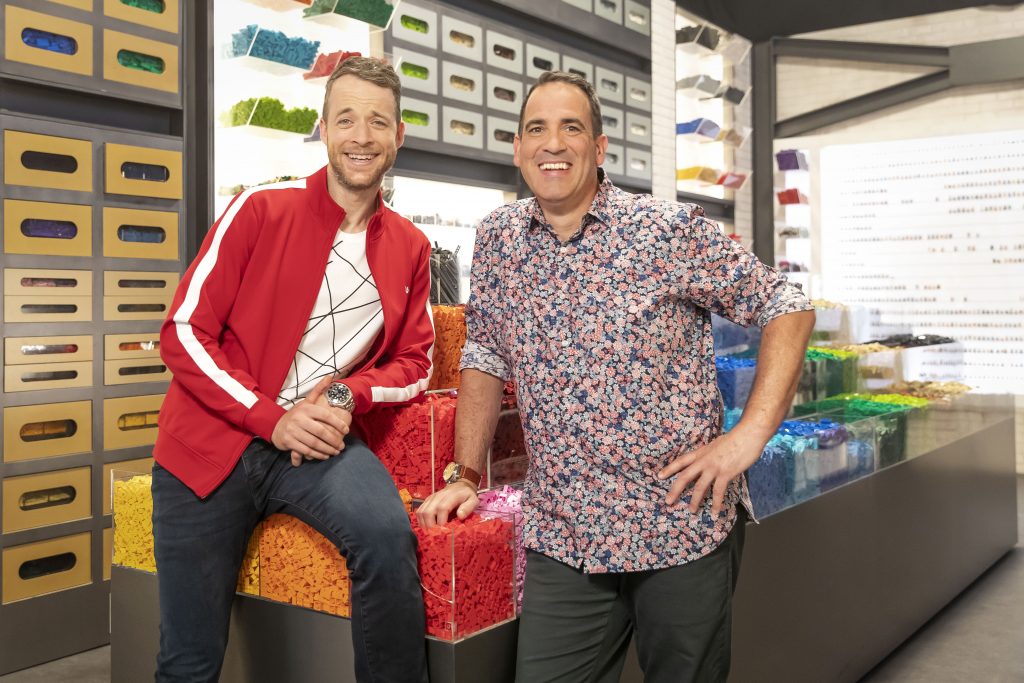It’s the little building block that took over the work, brick by brick. Aimee Knight investigates the surprising world of LEGO.

In 1932, a Danish carpenter starts making stepladders, ironing boards, stools and wooden toys. Twenty-six years, two managers and one factory fire later, his company – now working in plastic injection-moulding – patents a novel stud-and-tube binding system that makes their building blocks unique. The bricks come in five colours: white, red, yellow, blue and green. Each one is stamped with the word “LEGO”.
In 2020, as society grows suspicious of billion-dollar businesses, the Reputation Institute reveals that LEGO is the most highly regarded brand in the world (for the fourth successive year, no less).
From humble beginnings in the village of Billund, Denmark, to a benevolent empire built not just with bricks but with TV series, feature films, videogames, amusement parks, educational programs, technological advances and tactical marketing moves, LEGO has retained its original raison d’être: to stimulate every kid’s creative potential through the radical act of play.
The word LEGO combines two Danish words, leg godt, meaning, “play well”.
Myriad studies have shown that physical, creative, emotional, social and, yes, even digital play are vital to childhood development. Constructive play hones motor skills and problem-solving techniques. When kids play together, they learn to cooperate and compromise, boosting their resilience in adulthood.
Play even “activates the DNA that triggers the phases of human growth”, says LEGO’s own Play Well Report. If kids don’t get enough playtime, they can miss key developmental milestones, which has a profound effect on the type of grown-ups they become.
Play isn’t just integral to a little tacker’s wellbeing. It’s a nourishing, joyful pastime for big kids too, relieving stress, improving productivity, and bolstering our overall wellbeing. Yet the carefree pursuit of play “gets beaten out of us as we get older,” says LEGO enthusiast Ryan McNaught. “You’ve got to hang on to it. You’ve got to do something you love.” He’s leading by example.
Also known by his nickname “The Brickman”, McNaught is an LCP – a LEGO Certified Professional – who turned his passion for the bricks into a full-time gig. One of 15 LCPs worldwide, and the only one in the southern hemisphere, McNaught lives in Melbourne, where he left the corporate sphere to start his own LEGO-centric business. Now he makes those glorious models for shopping centres, museums, touring exhibitions and even LEGO offices around the globe.
While McNaught and his 13 full-time staff members aren’t employed by LEGO itself, they are among the lucky, talented and diligent adults who play with LEGO for a living. (Non-professionals might have to make do with Adult Night at Melbourne’s LEGOLAND Discovery Centre.) If you are reconsidering your career path, the LEGO Group’s online job board lists 200-plus available positions, at the time of writing. Not everyone can be a LEGO Master Builder, of course, but everyone has their LEGO origin story, says McNaught.
“Even though it was my third birthday, I remember it quite clearly,” he says, casting his mind back to 1975. “My grandparents were [living] in Tottenham – West Footscray – and it was pouring rain, absolutely belting down outside.” He recalls sitting at the foot of his Grandad’s chair, on the standard-issue suburban shagpile carpet, when his Nanna handed him a tiny box. It had set her back 28 cents.
“I remember opening this thing up – I didn’t know what it was or how it worked – and I remember this feeling of love and contentment, like all was well. It was my birthday, I was with family, and it was wonderful.”
McNaught was devoted to LEGO until he hit his teens. “Sport took over, you know? BMX, footy, cricket. We would have played with it occasionally, but it just…wasn’t a thing anymore,” he says. “It wasn’t until I had kids that I got back into LEGO. I have twin boys, so I had no choice,” he laughs.
Comedian Hamish Blake – McNaught’s co-host on LEGO Masters – recounts the same trajectory, “a well-worn path” known in LEGO lingo as “the dark ages”. A self-described “child of the 80s”, Blake grew up playing with LEGO’s space and medieval sets. Like McNaught, his interest petered out as a teen, reawakening when he became a dad.
“I was building a lot of stuff with my little boy, and making Duplo with my little girl,” he says. “Then out of nowhere comes LEGO Masters…at quite a perfect time in my own personal LEGO journey.”
Last year, LEGO Masters was a solid gold hit for Channel 9. The reality series saw eight duos race the clock to build remarkable LEGO structures. The inaugural winners, Henry and Cade, bagged $100,000 in prizemoney – plus a giant LEGO trophy – for their model of Poseidon battling a sea serpent, in a series finale that attracted 2.3 million viewers.
On set shooting the final challenge of LEGO Masters’ second season, the tension is palpable. The six remaining contestants – whose identities we’ll withhold; no spoilers here! – are in the midst of a gargantuan challenge, intensified by the January heat and some very tender fingers. One contender has even started to dream in LEGO.
All things considered, though, everyone’s very amicable. There’s no backstabbing or undercutting that’s par for the course on other reality shows. “We’re doing a competition about creativity and fun,” says Blake. “That’s why it never gets nasty or toxic. It wouldn’t make sense for our show.”
“Those contestants are all helping each other,” adds McNaught. “‘Oh, you need this piece? Here, I’ve got some of those.’ That happens all the time.”
“What I love about LEGO Masters is the tone,” says Blake. “The more fun and imaginative, the better the show is.” He’s in awe of the contestants, who gladly tackle whatever the show throws at them, logistically and creatively, in this celebration of design, construction and storytelling.
“If any part of your day-to-day life relies on ideas,” says Blake, “it’s a great reminder that there’s infinite ideas.”
Indeed, if you have a sweet concept for a LEGO set that doesn’t exist yet, you can pitch it on the LEGO Ideas website. If your project gets traction, you might join the hallowed ranks of the LEGO Fan Designers. This initiative is just one way in which LEGO has modernised its offerings, as McNaught discovered when he emerged from his own LEGO dark ages in the mid-2000s.
While he was pleased to see that the new bricks were basically the same as the old bricks – LEGO being one of very few brands that has, by and large, resisted planned obsolescence – what blew him away was the contemporary integration of new technologies.
“When I was a kid, I would build a little fire station and it would have a little fire truck. Nowadays, you can make a LEGO fire truck that’s completely automated and has a remote control on your phone.”
Launched in 1998, the ever-evolving LEGO Mindstorms range offers robotics kits with motors, sensors, LEGO Technic parts and a programmable brick that speaks to smart devices. Similarly, LEGO Boost is a simple, step-by-step platform through which kids as young as seven can learn basic coding.
Merging digital and tangible worlds is “the real secret to engaging children today in different ways,” says McNaught. But what of LEGO’s efforts to engage different types of kids? Believe it or not, that quest goes back almost to the company’s inception.
In 1963, Godtfred Kirk Christiansen – then managing director of the LEGO Group, and third son of company founder Ole Kirk Christiansen – presented the company with LEGO’s 10 essential characteristics. The first was “unlimited play potential”. The second? “For girls and for boys.”
Now, some might say that LEGO’s entry-level engineering systems primarily appeal to boys’ innately analytical minds. Others might see such gendered notions as akin to McNaught’s fire truck – merely a construct. The fact remains: despite LEGO’s neutrality – and the company’s assertion that their famous yellow “minifigure” has neither gender nor race – their product was found only on toy catalogues’ blue pages for many decades.
“As a society, we need more female engineers and mathematicians, and LEGO is a great stepping-stone for that,” says McNaught. Over the past five or so years, in line with the rising popularity of LEGO’s Friends and Disney lines, he’s been pleased to see some gendered misconceptions slowly dismantled.
Similarly, dads like Blake are building new futures for and with their boys and their girls, handing down vintage LEGO sets with the reverence of a family heirloom. Not only will this shape the next generation of STEM professionals, but it saves tonnes of virtually indestructible plastic from ending up at the dump.
By 2025, the LEGO Group wants to ensure that no waste from its workshops, offices and outlets reaches landfill. Factories across Denmark, Germany, England, the Czech Republic and Mexico are reducing their carbon footprint by using renewable energy sources. Before the decade is out, every LEGO brick will be made from recycled or plant-based materials. A botanical “Plants from Plants” set is already available, made from polyethylene derived from sugarcane.
“There are drives to send LEGO to places like Africa and India,” McNaught adds. Initiatives like Play Well Africa, or LEGO Replay in the US, ensure your unwanted bricks enjoy a long, creative life. This, in turn, fosters (further) love for the brand across widespread communities, meaning LEGO future-proofs itself against an influx of cheap imitations.
Last year, Chinese authorities raided a factory in Shenzhen, confiscating about $50 million worth of counterfeit bricks labelled “Lepin”. Based on LEGO’s own blueprints, these knockoffs usually sell for a fraction of the original’s price. Does McNaught feel a sense of brand loyalty to LEGO? After all, they broke the mould.
“LEGO has a system of play,” he explains. “Bricks go together in a certain way. I have an affinity to that…and, you know, as a company they have very wholesome values. They don’t do military, war, politics, religion. I want that in the toy.”
Instead, in April, the company’s Billund factory started manufacturing 13,000 visors per day for frontline healthcare workers battling COVID-19.
“Fads come and go [but] LEGO transcends all of that,” says McNaught. “When you build something, you can talk about it: ‘Mum, look what I’ve made! This is where the dinosaur lives!’
“What LEGO still has above any other toy is the pride of creation,” he says.
May we go forth and play well.
Aimee Knight is Small Screens Editor of The Big Issue.
First published in Ed#610
Image: Hamish Blake and Ryan McNaught on the set of LEGO Masters. Photo by Nine Network.
